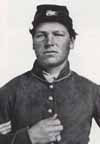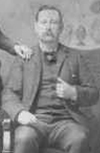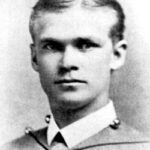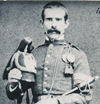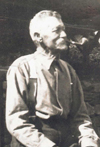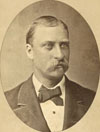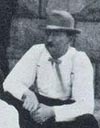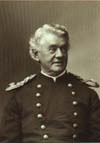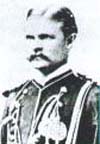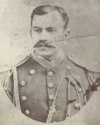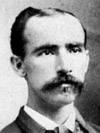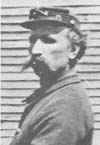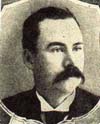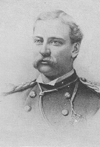Benjamin Beck was born on October 15, 1852, in Philadelphia, Pennsylvania. He was a Private in the Band, so he was on detached service at the Powder River depot.
Frederick Deetline (left) was awarded the Medal of Honor on October 15, 1878, for his actions during the battle.
Thomas Wellesley Causby (right) died on October 16, 1906, in Davenport, Iowa, and was buried in the Oakdale Memorial Gardens there. He was a Sergeant with the Quartermaster who was not present at the battle due to detached service at Powder River.
Ernest Albert Garlington (left) died in Coronado, California, on October 16, 1934, and was buried in Arlington National Cemetery in Section 3, Grave 1735-BSH. He was a Second Lieutenant assigned to Company H who was not present at the battle because he was on leave after his graduation from West Point.
Fremont Kipp (left) was born on October 17, 1856, in Noble Hill, Noble County, Ohio. He was a Private in Company D who was in the hilltop fight.
Benjamin C. Criswell (right) died on October 17, 1921, in Eldorado, Jackson County, Oklahoma, and was buried in the Pleasant Hill Cemetery in Gould, Harmon County, Oklahoma. He was a Sergeant with Company B who rode with the pack train and was wounded during the hilltop fight. He was awarded the Medal of Honor on October 5, 1878, for his actions during that fight.
Anton Seibelder [gravestone is incorrect] died at the Soldiers’ Home in Washington, D.C., on October 18, 1913, and was buried in the National Cemetery there. He was a Private in Company A who participated in the valley and hilltop fights during the battle.
Michael Reagan, who was also known as John Desmond, was born on October 19, 1834, in Queenstown, Cobb County, Ireland. He was a Private in Company K who was not present at the battle due to detached service at Powder River.
Samuel Frederick Staples was born on October 19, 1849, in East Douglas, Massachusetts. He was a Corporal in Company I who was killed with Custer’s Column.
Charles Adolph Stein committed suicide on October 19, 1891, in St. Paul, Minnesota, and was buried there in Oakland Cemetery. He was a Veterinary Surgeon with the 7th Cavalry who was at the Powder River Depot during the battle.
Frank Lambertin died on October 20, 1913, in Prescott, Yavapai County, Arizona, and was buried in Citizens Cemetery there. He was a Private in Company H who was not present at the battle due to illness.
James Augusta Abos died on October 20, 1925, in the Bronx, New York, and was buried in Woodlawn Cemetery there. He was a Private assigned to Company B but was not present at the battle because he was confined at Fort Leavenworth, awaiting trial for desertion.
George Kelley died on October 21, 1922, in Leavenworth, Kansas, and was buried in the National Cemetery there. He was a Private in Company H who was not present at the battle due to detached service with General Terry’s column.

